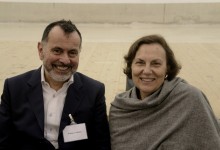Forum Presentation
Notes on the Biennale, which have become a hybrid conglomerate, consisting of
Transcultural intellectual and artistic relations,
Production-consumption process of culture ındustry,
Global-market interests,
Collector-sponsor-corporate art assets…
1.Optimistic approach to biennale
-Biennale have become multi- cultural international or more accurately transcultural exhibitions and have immensely contributed to the networking and exchange between very differently structured art scenes all over the world.
-The distribution of these kinds of exhibitions into region or city based locations also played a role in reducing the authority of modernist exhibition structures based on local nation state ideologies or 20th century Eurocentric proclamations which still prevail in the culture policies of many states all over the world.
-Within the conditions of globalization, artists and artworks are in constant move and the mediation possibilities are high. The virtual space – the internet- contributes to this exchange of visual and creative thinking and production.
-Since the end of 80’s, the exhibitions and related events such as symposium and workshops organized in the Balkans, Middle-East and South Caucasus in collaboration with EU institutions and funds significantly reflect this necessity of communication and appreciation not only between the creative individuals seeking new audiences and markets but also between different cultural systems that are exposed to political and economic transformations seeking new allies and partners to tackle and overcome the grandeur of this task.
-The intense art exchange within the region where Istanbul is the center of early accomplishments in global culture industry system consists of multilateral exhibitions, roundtable or symposium meetings and artist residencies. These have been initiated quite early by forward-thinking local and curious international curators with the support of the institutions of EU.
2. A little critical approach to the biennale
In most of the Non-EU countries interactions are between the official or semi-official EU institutions and individuals and private or civil initiatives. The state cultural policies in these regions are still under the spell of conservative and static modernist ideologies or strongly privatized.
Istanbul, being a center of attraction, because of its historical-traditional and post-modern fusion and its booming economy, has in fact all kinds of examples of discrepancies and mal-functioning interactions.
The international art market has still its reservations to enter into these countries, including İstanbul. Yet, one cannot say that the art market is not influencing the curators in their endeavor to curate exhibitions there.
Evidently, nowadays it is very fashionable for an artist to exhibit in one of the shows in Istanbul; sometimes they question their orientalist heritage or sometimes they look for human drama, social and political discrepancies that don’t exist in their native territory.
3. An additional critical approach to the biennale
In Turkey the effect of EU cultural policies started beginning of the 90’s on individual networking level and gradually developed into private-institutional relationship. The private sector institutions are building monopolies and normalizing art productions and their aesthetics according to their corporate interests. These monopolies can be clearly observed in the structures and aesthetics of Istanbul biennale.
In fact the biennale concepts are being criticized by groups of artists and initiatives as serving the corporate interests rather than the contents and goals of art.
In accordance with the global economy and politics contemporary art making and productions in Turkey gained independency, autonomy and recognition; but is still dependent on the art market due to the lack of official funds and public money.
The rupture between the Istanbul based contemporary art productions and Ankara based state cultural policy is precariously distinct.
Istanbul art scene is dependent on EU culture and art initiatives and interests even when EU institutions are running into severe budget cuts.
4. Looking awry from Istanbul to the contemporary art system
The Gaze of global contemporary art system, corporate art institutions is quite suspicious and anxious. It looks over (it avoids) some fundamental facts:
– In the course of globalization, the expansion of capital on a world-wide scale produces, as a reaction, all manners of local cultural resistances in the name of cultural, linguistic or ethnic identities.
– Transculturality in the form of immigrant art and artists is a mirror that reflects the profound cultural crisis which is accompanying globalizm.
– Not only the Non-EU but also EU nations are undergoing a profound cultural crisis of identity because globalization is depriving them of their economic and political independence.
– The international exhibitions of the last decade, evidently we cannot deny that the international exhibitions – biennale or major institutional shows- that have been organized by EU and USA curators have definitely served the absent countries to be part of the game, however at the same time these exhibitions were labeled as “multi- culti communication” or “ethnic marketing”.
– The paradox is –it is difficult to decide whether it is positive or negative- that, up until today major political ruptures, upheavals and even wars in the region have stirred the desire and volition for communication and dialogue through art and culture.
For example, the Middle East artists had an unforeseen access into the international art milieu after the Post-Gulf War and the Balkan Conflict aroused the interest of EU intellectuals and artists to the traumatized Balkan cities. After 9/11, when the definitions Islam, Axis of Evil and Terror reflected new political and cultural divisions together with their spheres of influence, the Middle and Far became again the destination of desire and dissidence, an experimental field for official cultural policies of EU.
Since a decade the majority of exhibitions, particularly the biennales and cultural events are structured within these conditions, manifesting multiculturalism, in combination of religious, ethnic or traditional diversities and particularities.
In her inspiring speech in 1994 AICA Congress in Stockholm and Malmö Julia Kristeva has indicated that contemporary art is at the heart of speculation, commercialism, the show business society and what since the fall of the Berlin Wall, has become known as the New World Order at that time. (1)
How can we evaluate this after twenty years in conjunction with the biennale exhibitions?
We cannot argue the advantages of the so called New World Order in liberating and increasing the artistic and cultural exchange between territories that could never communicate with each other. Evidently, there is an ever growing temptation to discover new or unknown art scenes probably as the eternal heritage of orientalism and apparently due to the strange ferment that is made of the contemporary art making and art market all over the world.
However in the age of globalization, of multi-cultural allegations and of total electronic image penetration, the interaction between artists, official and private institutions, galleries, dealers and the public are under the spell of all these dispositions, and their relationships are extremely complicated and often strained.
Kristeva further signifies the situation as the essential aspect of European culture and art, the culture and art of revolt, is under threat and says that we are submerged by entertainment culture and performance culture. However since that time, the dissident art productions have gained a significant recognition within the biennale; but on the other hand the dissident art is being tamed by the corporate art system. The reason of complicated dispositions and strained relationships is this submerged position of the art and culture of revolt. Revolt is still the essence of art making and aesthetic experience interpreted by art criticism for the public. Kristeva even says that revolt is an integral part of pleasure principle; and without this pleasure we cannot be content with shows and performances.
In this regards, when the standardizing entertainment and show culture which has an immense economic value within the global capitalism, interferes and manipulates the art and culture of revolt, the paradox is that the public will not experience pleasure, aesthetic perception and visual contentment.
Exhibitions with Transcultural ambitions cannot escape these realities. As nothing much has changed since Kristeva’s speech in the sense that entertainment industry has never withdrawn its claims on art and culture, and the world is enduring worst kind of transformations, such as ongoing Iraq crisis, Syria civil war, EU economic depression and many other local catasthrophes.
We must re-think and re-form the content and form of the international exhibitions within these dispositions. We have to find less sophisticated, artist-friendly and down-to-earth strategies to revive the power of art to mediate between cultures and policies. As a curator in this territory I prefer to go after the artists who are fully aware of this call it crisis or phenomena, who are thinking and creating art beyond the visible and official facts of the cultural relations with hegemonies and monopolies, who can carry the burden of transmitting micro and macro culture entities- which is obviously inevitable – with criticism, with a strong consciousness and an unpredictable sense of humor.
Beral Madra, April 2013
1. Julia Kristeva, “What Good Are Artists Today?”, Strategies for Survival-Now!, Ed. Christian Chambert, The Swedish Art Critics, 1995, p.25-37


